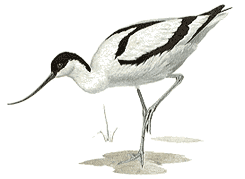Avocet

| Class: Aves: Birds |
Diet: Insects |
| Order:
Charadriiformes: Auks, Waders, Laris |
| Size:
42 cm (16 1/2 in) |
| Family: Recurvirostridae:
Avocets |
Conservation Status:
Non-threatened |
| Scientific Name: Recurvirostra
avosetta |
Habitat: mud flats,
estuaries, sandbanks |
| Range:
Europe, western and central Asia; northern populations winter in western
Africa and southern Asia |
 An
unmistakable bird, the avocet has striking black and white plumage and
a long bill that curves upward. In flight, the long legs usually project
beyond the tail. Avocets feed on insects, small aquatic animals and some
plant matter, all of which they find by sweeping their bills from side
to side at the surface of mud or shallow water. In deeper water, the avocet
dips its head below the surface and will swim and up-end like a duck.
Avocets breed colonially; pairs mating after displays involving both partners.
The nest is usually a simple scrape near water in which the female lays
3 to 5 eggs. Both parents incubate the eggs and later guard their chicks
against predators. Juveniles have some brownish plumage but are otherwise
similar to adults. The American avocet, R. americana, resembles this avocet,
but has cinnamon plumage on head, neck and breast during the breeding season. An
unmistakable bird, the avocet has striking black and white plumage and
a long bill that curves upward. In flight, the long legs usually project
beyond the tail. Avocets feed on insects, small aquatic animals and some
plant matter, all of which they find by sweeping their bills from side
to side at the surface of mud or shallow water. In deeper water, the avocet
dips its head below the surface and will swim and up-end like a duck.
Avocets breed colonially; pairs mating after displays involving both partners.
The nest is usually a simple scrape near water in which the female lays
3 to 5 eggs. Both parents incubate the eggs and later guard their chicks
against predators. Juveniles have some brownish plumage but are otherwise
similar to adults. The American avocet, R. americana, resembles this avocet,
but has cinnamon plumage on head, neck and breast during the breeding season.

  
|
